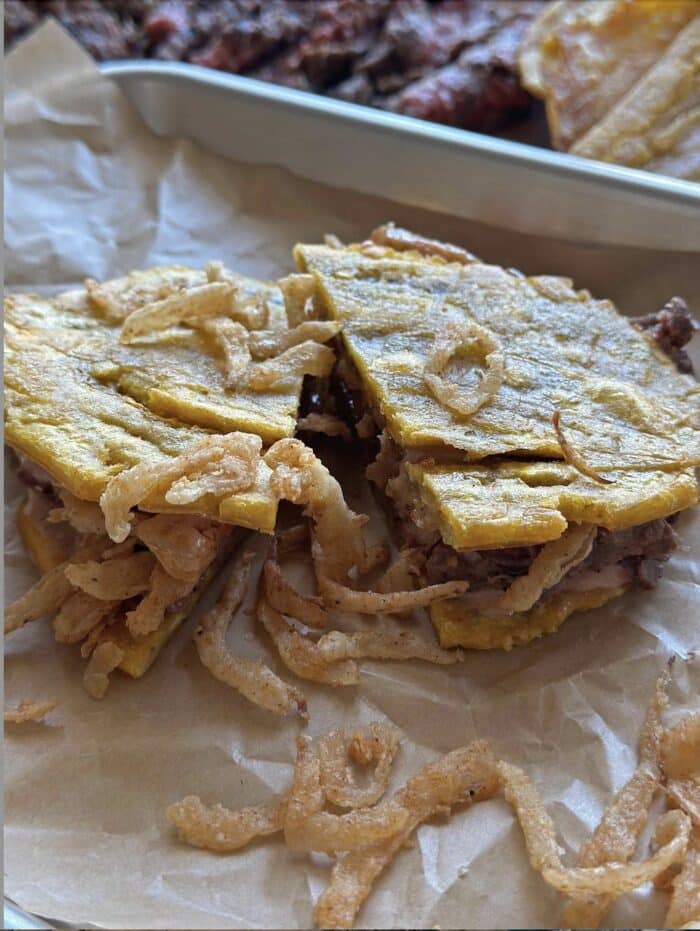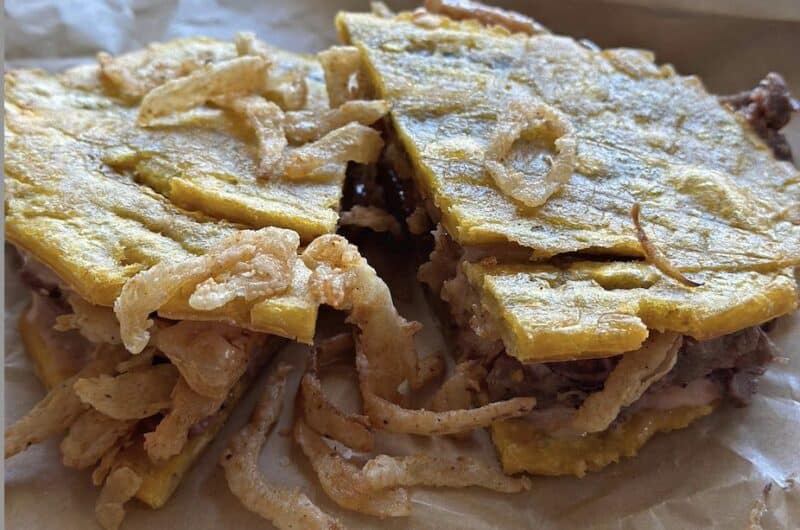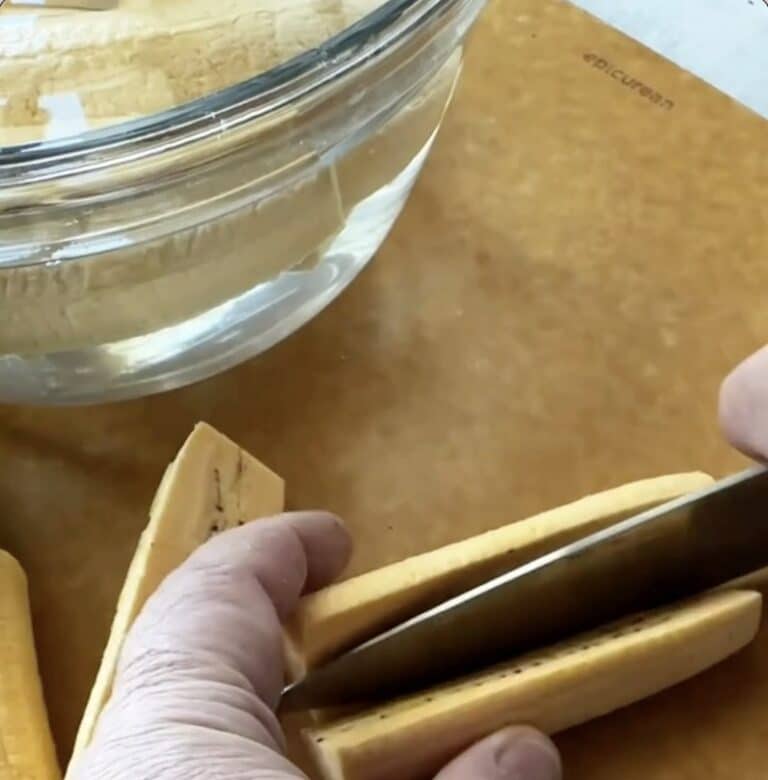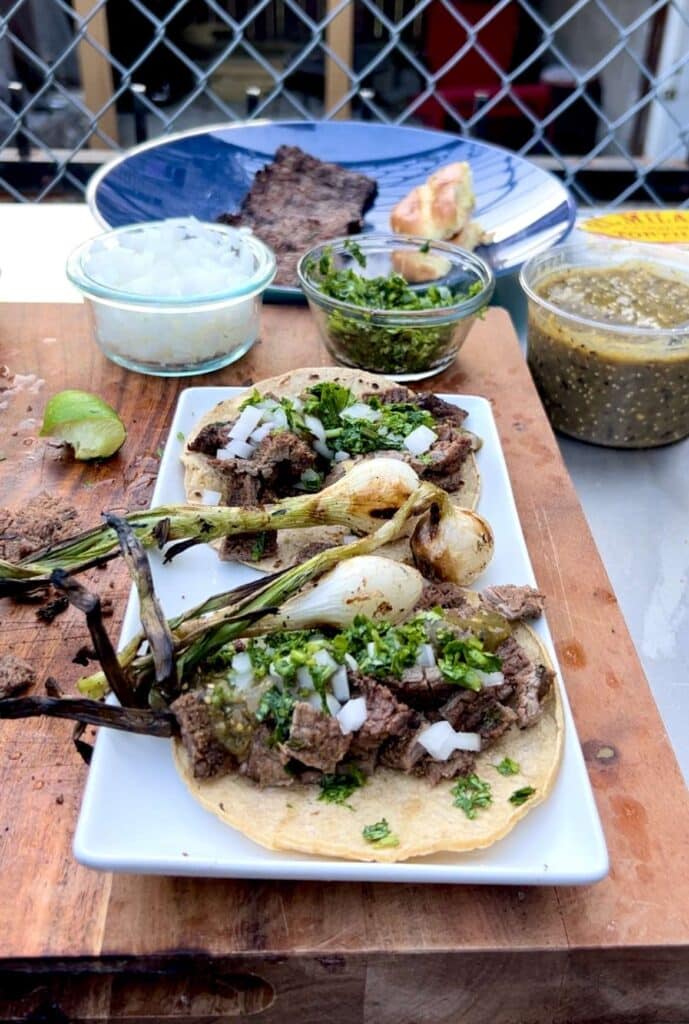Jibarito, Puerto Rico’s Star Sandwich with Plantains & Beef
- June 2024
- By Michelle Ezratty Murphy
- Recipe from Puerto Rico
-
- (1)

The jibarito sandwich is one of the newer stars in the Puerto Rican food galaxy. This addictive marriage of crispy plantain “bread’ and juicy marinated beef was dreamed up in the last three decades, though by which restaurant and when is contested to this day.
Its origin story may be debated, but there’s no denying that the jibarito sandwich skyrocketed in super-popularity super-fast. Today, these crunchy, delicioso plantain sandwiches are sold by in-the-know Puerto Rican food trucks, street vendors, and select restaurants across the U.S. and on the island.
In honor of the Puerto Rican Day Parades happening this week in New York City, Chicago and other U.S. cities, we asked one of our favorite Puerto Rican food cooks Michelle Ezratty Murphy to show us how to make her family-famous jibarito sandwich. Check out her recipe!
But First: What Does Jibarito Mean?
The word jibarito is a Puerto Rican endearment for a humble farmer/field worker, the island’s homegrown take on a hillbilly. In the way that Uncle Sam represents the U.S., a jibaro symbolizes Puerto Rico. The iconic image of a noble farmer, a machete in one hand and a straw pava hat on his head, is used in folksy ways all over the island as a symbol of authenticity and Boricua pride.
The sandwich likely got its name because it’s made with one of Puerto Rico’s most affordable, locally grown and beloved ingredients: the plantain. To make this sandwich, young, very green plantains must be used. When smashed and fried, they are called tostones and are one of the island’s favorite sides.
The secret to the sandwich’s popularity is the explode-your-taste-buds interaction between the salty-crispy plantains and the juicy-savory beef. Add a dash of adobo to the marinade, throw in lettuce, tomatoes and onion, plus a creamy slather of garlicky mayonnaise, and it’s no wonder this sandwich has become a Puerto Rican culinary hit.
Still, Michelle Ezratty Murphy, one of our favorite Puerto Rican food cooks, had never even heard of a jibarito until she saw the sandwich listed by a street vendor a few years ago.
“The jibarito is new to me,” she explains. “Growing up in Puerto Rico, you would have thought I would have eaten it at least a dozen times, but it wasn’t until I moved to Arizona, that my husband and I happened upon a small Puerto Rican food truck. The owners were from Ponce, and they had jibaritos on the menu.”
Who Made the First Jibarito?
The truth is there there is no way she could have eaten one when she was growing up in San Juan. The jibarito wasn’t even invented until sometime in the 1990s, depending on which origin story you believe. Perhaps the most accepted version of the jibarito sandwich’s start credits the owner of Borinquen restaurant in Humboldt Park, a Chicago neighborhood known for its Puerto Rican heritage. In 1996, Juan “Peter” Figueroa came up with the idea of using two huge tostones to bookend a beef sandwich, inspired by a similar dish from Venezuela called patacon. An earlier story dates the creation of the jibarito to 1991, when it was created in Aguada, Puerto Rico by the restaurant Plátano Loco.
More recently, a Chicago restaurant named Jibaritos y Mas has taken up the mantle and gone all in on this delish dish. The popular eatery expanded the plantain sandwich’s filling options to lechon (roast pork), chicken, ham and cheese, shrimp, octopus y muchos más. Bonus: Their jibarito is served with the most Boricua of classic sides: arroz con gandules. Starchfest!
Michelle and her Puerto Rican-born husband Pat Murphy tasted their first jibarito that day in Arizona and were instantly smitten. “What wouldn’t I love about it?” says Michelle. “Huge crunchy tostones, salted and dusted with garlic powder, stuffed with marinated skirt steak and topped with crunchy onions.”
It was jibarito love at first bite.
How to Make a Jibarito Sandwich en Casa
When Michelle loves a dish, she must make it her own. “I knew that I needed to cook this Puerto Rican sandwich at home,” says Michelle.” So, with Pat Murphy, her husband, designated plantain peeler and official Boricua food taster, she went into her kitchen and started experimenting, she tells us.
“The classic way to make a jibarito is with some sort of marinated beef, typically shredded or roasted. I was inspired to grill mine like a carne asada, which is one of my favorite meals. I lean towards skirt steak because it’s a tender flavorful steak that marinates well. When sliced against the grain (on the bias), it’s a perfect match for sandwiches because it’s so tender. I love how it piles nicely on the jibarito and looks really pretty, too. Honestly, it’s the only way I would make a jibarito, as it mimics the classic bistec sandwich, which can also be made with lettuce, tomato and skinny fries,“ she says.
How to Fry the Plantain “Bread” and Crispy Onions
Next up, plantains. “My husband is very particular about the way we cut and smash the platanos. We were going to use our tostonera (plantain press), but found it just wasn’t wide enough. We thought about using a can, but that didn’t work,” she says.
“So my next idea was to use a tortilla press. Perfect! We smashed the plantains to the perfect thickness and width.” Michelle admits that figuring out how to make the oversized tostones was a little daunting at first. “It’s a little time consuming, because it takes a double fry to cook them to crispiness, but certainly well worth it.”
The third challenge was to figure out was how to get crispy onions, she adds. They have to be thin and crunchy; not too thick, not too doughy. “I could buy them at the store in a can, but for some reason, I just thought that wouldn’t do justice. So I tested a bunch of frizzled onion recipes, and came up with what I thought gave me the best crisp. I use a combination of flour and cornstarch, which in my estimation, is the perfect fry.” Michelle offers this insider tip to fellow crispy-cebolla perfection seekers. “Cutting the onions on a mandolin is a must, because they have to be super thin, like paper.”
And then there’s Michelle’s final jibarito decision: What spread to use on the fried-plantain flats? Instead of garlicky mayonnaise, Michelle opted to tap her go-to condiment, another classic from Puerto Rico: Mayoketchup. Like its name says, the condiment is a mix of equal parts mayonnaise and ketchup. Essential, delicious and a crowd-pleasing must-have with papitas, Michelle knew this condiment would be a hit slathered on salty fried plantains. And it was, she reports. Her husband declared her jibarito to be the best he’s had.
Michelle, gracias for sharing your jibarito recipe with Familia Kitchen. It’s la receta perfecta to celebrate Puerto Rican culture and heritage this week of National Puerto Rican Parades. That said, you don’t need to be a Boricua to love this sandwich, Michelle recommends this recipe to ”anyone with Latino heritage and everyone else who likes fried plantains. We’ll start with my husband. If he could eat every sandwich as a jibarito, he would.”
Ready to Make a Puerto Rican Jibarito Sandwich?
MoreLike This












Got a question or suggestion?
Please rate this recipe and leave any tips, substitutions, or Qs you have!